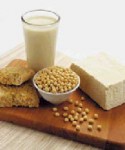SOY AND ITS PROPERTIES
Supplements of soy isoflavones
WHAT 'THE SOY:
Soybean Glycine max or is a food of great value that is getting increasingly popular in feed not only vegetarians, but of all the people who care to wellness.
Soy is a herbaceous plant of the Leguminosae family, originally from East Asia and cultivated for food purposes.
Soy is a legume rich in vegetable protein of high quality, have a similar taste to the beans and can be eaten as a vegetable.
The Soybean is composed of 44% protein, much more than other legumes.

Are derived from soybeans also many foods on the market: soybean oil, soy flour, soy sauce (excellent condiment used in Chinese cooking instead of salt), soy milk, soy ice cream, tofu (a cheese made bean), hamburgers and sausages, meat substitutes for vegetarians.
Its cultivation was started in China at least 5000 years ago. In Europe, the soy initially came as an object of study in the botanical gardens and only in the nineteenth century it began cultivation. In America, soy was already mentioned by Benjamin Franklin in 1775, but its cultivation began significantly only in the early twentieth century.
SOY ISOFLAVONES:
Soy contains isoflavones such as genistein important and daizeina, also known as phytoestrogens because of their similarity to estradiol, the main female hormone.
The phytoestrogens contained in soy can effectively protect men from prostate cancer and women from diseases related to the production of estrogen, such as breast cancer, endometriosis, fibrocystic disease (ie, fibrocystic breast disease), fibroma of ' uterus and menopause symptoms. (The low percentage of these diseases between oriental women may be due to their high consumption of soy-based foods, especially of tofu.)
Soy isoflavones act like all estrogen balancing both conditions of estrogen excess (like PMS) and of estrogen deficiency (like menopause), bringing hormones to proper levels.
Therefore represent a good alternative to synthetic hormones often used to combat precisely the problems of menopause, but with unpleasant side effects which are instead completely absent in phytoestrogens.
It 'important to note that soy isoflavones are estrogen modulators of the estrogen but. Acting in fact in a different way by binding to two classes of estrogen receptors present in the body. On alpha mostly found in the breast and reproductive organs, isoflavones have an anti-estrogen. Instead binding to beta receptors that are found mainly in the bones and vessels, genistein and diazeina exert an estrogen-like stimulation of protective tissue. In fact so isoflavones can reduce menopausal symptoms and also help protect against osteoporosis.
THE SOY LECITHIN:
Soy also gives also an important substance for the welfare of: lecithin, a natural emulsifier that keeps the suspension of cholesterol in the blood by preventing the formation of deposits on the artery walls, creating the risk of cardiovascular disease.
E 'therefore useful to combat high cholesterol.
ABSORPTION:
The soybean as other legumes, contain natural substances that interfere with the absorption of protein and minerals such as calcium and zinc. However, they have a modest impact on absorption.
Supplements of soy isoflavones
